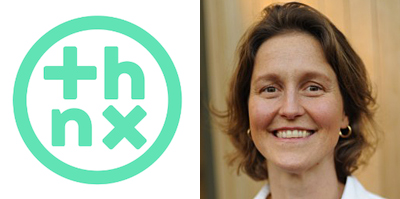Thnx4.org goes live to both teach and research the power of gratitude
Along with turkey and pumpkin pie (and elections), November is a month for giving thanks. And now UC Berkeley’s Greater Good Science Center is serving up an easy way for people to do just that — and, at the same time, contribute to a national research project and maybe also improve their lives.
The center just went live with Thnx4.org, a new, interactive, shareable gratitude journal that’s the modern equivalent of a spiral notebook, stationery and a roll of stamps. For the next month, people in the campus community are invited to take part in the Cal Gratitude Challenge by keeping a two-week online “gratitude journal” and, if they choose, sharing their posts with others.
Early research into the power of gratitude by Bob Emmons, a UC Davis psychology professor who has played a role in the launch of Thnx4.org, began among students keeping gratitude journals in actual spiral notebooks, says Emiliana Simon-Thomas, GGSC science director and lead researcher on the new initiative. The journals ended up proving that students who wrote down everything they were grateful for strengthened their overall resilience and became less vulnerable to everyday stresses and complaints like rashes and headaches, says Simon-Thomas, who earned her Ph.D. in psychology at Berkeley.

The project is part of a $5.6 million, three-year national effort called “Expanding the Science and Practice of Gratitude,” funded by the John Templeton Foundation. Some $3.1 million of that money came to the Greater Good Science Center, which designed Thnx4.org with the twin goals of conducting research and educating people about the power of gratitude. The center also is dispensing research grant money to postdocs and graduate students nationwide.
The Cal Gratitude Challenge addresses both the education and research goals. People can take part by going to the Thnx4.org website, signing up and making daily posts about things or people that have made them grateful. They can also share the posts with others through Facebook, Twitter or email. And each time they post, they’ll get a tip on gratitude. A recent post, for example, elicited this advice: “What would life be like without your special someone? Without a close friend? Picturing your world without things and people you value can make you appreciate them more.” The whole interaction is designed to take just 5 or 10 minutes.
Both before and after the 14-day period, participants fill out surveys intended to measure traits like resilience, attachment tendencies and happiness. The surveys will be compared to see how posting and sharing — called a gratitude intervention — may affect their general disposition and their emotional and physical well-being.
Gratitude database
The results — basic demographics and information on what kinds things make people grateful and how keeping the journal affects them — will provide a rich database for exploration by gratitude researchers, Simon-Thomas says. The project’s designers are hoping for 1,000 participants.
Researchers will seek to answer questions such as: Does gratitude for a person have different effects than feeling grateful for, say, a new iPad mini? Which gender is more willing to spread gratitude? Does a moment of gratitude predict the likelihood of a pay-it-forward response? Is there a regional geography of the more- and less-grateful?
The project builds on research that demonstrates the power of expressing gratitude, says Simon-Thomas.
“Studies show that people who have gone through trauma have a greater resilience against post-traumatic stress disorder if they have a biological predisposition to be grateful — or if they go through gratitude intervention,” says Simon-Thomas, providing one example of what she says is a growing body of research.
Another study compared the actual sending of a gratitude letter versus just writing one, and found that knowing that the person it’s addressed to is going to receive it is a more powerful intervention, says Simon-Thomas. Thnx4.org’s design will allow researchers to make a similar comparison between people who share their journal entries and people who don’t.
The project also will try to capture information about the experience of being on the receiving end of an expression of gratitude.
The concept has been designed to be flexible, so it can be repeated in modified forms for various populations all over the world in the future, say its founders. For use among hospital employees, for example, it could be tailored to assess issues like caregiver burnout, according to Simon-Thomas.
“Maybe we’ll have the opportunity to run it at Google, and find out something about how worker well-being changes people’s physical or emotional makeup,” she says.
A booming field
For now, Berkeley is the first testing ground. The Cal Gratitude Challenge opened Nov. 1 and will remain live online throughout November — though participants will be able to maintain their journals after that. First results from the data are expected in January.
Gratitude research is a booming field. The Greater Good Science Center received more than 275 proposals from research teams at the nation’s top universities — UCLA, Harvard and Emory among them — and selected 14 for grants through the “Expanding the Science and Practice of Gratitude” program. Research topics span a wide range from brain studies to measuring the impact of gratitude on heart disease in chimpanzees. Proposals from graduate students, now being considered, will receive the next round of funding.
Thnx4.org was the idea of Jason Marsh, editor-in-chief at the Greater Good Science Center, and it was built through an interdisciplinary effort that included Simon-Thomas, Emmons, UC Berkeley psychology professor and GGSC co-director Dacher Keltner and Greater Good web producer Jeremy Adam Smith, along with Chelsea Howe, a former game designer, and the Quilted Cooperative, a worker-owned design company.
